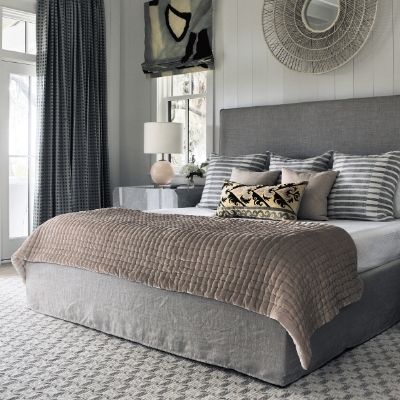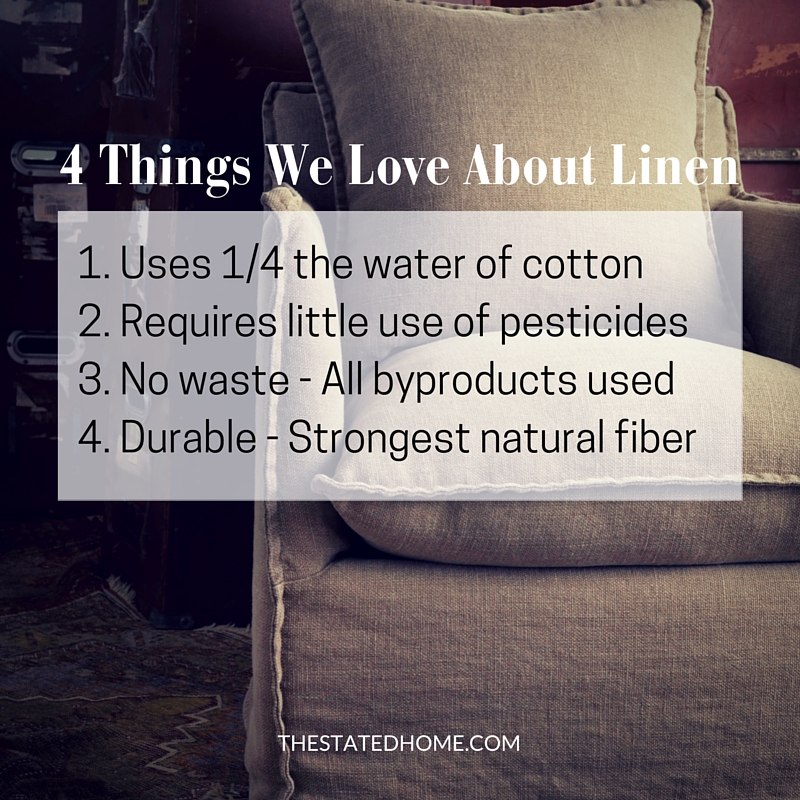 The mission of The Stated Home is to offer quality American-made products, but we ran into a stumbling block when it came to finding homegrown linen to upholster our sofas and chairs. So we decided to find out why there is no significant linen industry in the USA.
The mission of The Stated Home is to offer quality American-made products, but we ran into a stumbling block when it came to finding homegrown linen to upholster our sofas and chairs. So we decided to find out why there is no significant linen industry in the USA.
The key to that answer lies in how linen is made. Flax plants aren’t that difficult to grow, but the processing required to turn the plant into high-quality linen fabric is very labor intensive. And while textile processing has advanced for most materials, linen still has to be made the old fashioned way (aka no machine processing).
To understand why, you need to understand how the flax plant is turned into fabric.
Harvesting
First, the flax plants have to be harvested. The best quality linen fibers come from plants that are pulled up with the roots intact – not cut off at the soil level. No one has been able to invent a machine that pulls up the stalk with the roots intact, so the highest quality linens are still harvested by hand.
Processing (retting)
Once the stalks have been pulled from the soil, the fibers must be separated from the rest of the stalk. Surely, that can be accomplished by a machine, right? Wrong again. In order to separate out the fibers, the rest of the stem must be rotted away (yes, rotted). The technical term for this process is “retting” and it’s accomplished by allowing the flax stalks to ferment. Most commonly, the flax is weighted down and submerged in a slow-moving or stagnant body of water, like a pond, bog, river, or stream, until the stems rot.
This is, as you can guess, a stinky process that could take up to several weeks. It’s also incredibly important: The quality of the final fabric is dependent upon the retting process. In fact, that’s one of the reasons why Belgian linen is so legendary—whatever is in the River Lys in Belgium works wonders on the stalks (in fact, flax growers from France, Holland, and even South America send their flax to be retted in the River Lys).
There are other ways to get the stalk to rot, like spreading the flax in a grassy field, submerging it in large tanks of water, or relying on chemicals, but these all create lower quality fibers.
More processing (scutching and heckling)
Now that the stalks are retted, can’t machines finish the job? Well, yes and no. The retted stalks (called straw) are dried and cured by storing them for a period of time (anywhere from a few weeks to months). Then the straw is passed between rollers that crush any woody stalks that still remain (this is the first time a machine is used at all in the process).
To separate the remaining bits of wood from the fiber, someone has to scrape the fibers with a small wooden knife in a process called scutching. And it’s slow moving: Scutching yields only about 15 pounds of flax fibers per day per worker.
Next, the fibers are combed through a bed of nails (heckling) that removes the shorter fibers, leaving the longer ones. It is these long fibers that are spun into quality linen. At last, we are ready to spin, dye and weave.
Why don’t people do this in the US?
Although there are some individual hand spinners and weavers here, the labor-intensive process we just described means there is no significant commercial linen production in the US. As a result, the linen fabrics that are used to upholster American-made furniture must be imported from countries that still have a linen industry.
That includes Belgium, which we mentioned above, along with Ireland (the linen processed there tends to be grown elsewhere), France (they are noted for producing white, delicate fabric), Italy, and Scotland. Flax is also grown in Russia and China, though the fibers tend to be of poorer quality than those grown in Europe. Flax grown in the Nile River valley benefits from the rich soil found there.
Linen, an eco-friendly option
Despite the fact that linen is imported, it is still an excellent choice for upholstery fabric because it is extremely eco-friendly and durable. It uses one-fourth the water that cotton does during processing, requires little use of pesticides (cotton uses seven times more than linen), and produces little waste as every byproduct is put to use. It is for these reasons that we use European linen in our American-made products.
Like what you read? Visit thestatedhome.com to shop our collection of made-in-America furnishings.

Thank you for letting us know. I did not know before now.